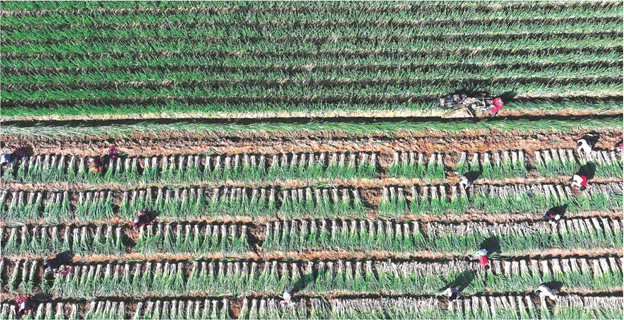The Dongchangfu District of Shandong Province is making waves with its innovative “wheat + leeks” double cropping model, a practice that is significantly improving agricultural productivity and farmer incomes. As the leek harvest season arrives in early November, this model is proving to be a vital strategy in maximizing land use and increasing profits.
The “Wheat + Leeks” Double Cropping Model
In the traditional farming cycle, land is typically used for a single crop per year, with farmers rotating between different crops based on the season. However, the “wheat + leeks” double cropping model, which has gained traction in Dongchangfu, combines wheat and leeks in a way that maximizes land efficiency and enhances overall agricultural output.
This method involves planting winter wheat before the “Minor Snow” solar term in early November, and after harvesting the wheat in June, leeks are planted immediately afterward. The leeks thrive in the summer months, and by the time winter approaches, they are ready for harvest. The model allows farmers to reap the benefits of two high-value crops from the same plot of land within a single year.
A Boost to Agricultural Income
The impact of this double cropping model is substantial. Farmers in the region are seeing increased land productivity and a boost in income. The success of the “wheat + leeks” system lies in the complementary nature of these two crops. Wheat, which is harvested in early summer, leaves the soil ready for the subsequent planting of leeks, which have a relatively short growing cycle and can be harvested in the fall.
Leeks are a high-demand vegetable, particularly in Northern China, where they are a staple in many dishes. With this model, farmers are able to capitalize on both wheat and leek markets. The leeks harvested in Dongchangfu are sold to large vegetable markets across regions such as Hebei, Beijing, Shanxi, and even the northeastern provinces of China. The harvest is often coordinated with peak demand seasons, ensuring strong market prices and demand.
Efficiency and Sustainability
This innovative approach to farming also promotes more sustainable agricultural practices. By utilizing the land year-round, farmers are maximizing its potential without the need for excessive land expansion. Additionally, the integration of these two crops provides better soil management and reduces the time fields remain fallow. The “wheat + leeks” model encourages farmers to adopt more sustainable, resource-efficient methods, contributing to the overall resilience of local agriculture.
The use of mechanization in the leek harvest, as seen in the photos of workers during the November harvest season, has further improved efficiency. Leek harvesting machines, which can quickly pull up leeks, bundle them, and prepare them for shipment, have streamlined the process, making it less labor-intensive and faster.
Challenges and Future Expansion
Despite its success, the “wheat + leeks” model is not without challenges. The coordination between wheat and leek planting requires careful timing and precision to ensure optimal growth for both crops. Moreover, while this model works well in the Dongchangfu region, its expansion to other areas may require adjustments based on local climate conditions, soil types, and water availability.
However, the positive results so far suggest that this model holds significant potential for other agricultural regions in China. With continued support from local governments and agricultural experts, this double cropping system could become a blueprint for sustainable farming practices across the country.





